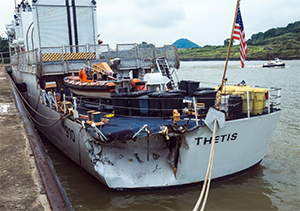Insufficient lookout was a key factor in a Panama Canal collision involving a U.S. Coast Guard cutter, American investigators said in a recent report.
The 270-foot Famous-class cutter Thetis was sailing toward the Pacific Ocean when empty scow barge 123, pushed by the 5,260-hp tug Matachin, slammed into the cutter’s stern. The incident occurred at 0111 on June 2, 2016, in a canal section known as Las Cascadas Reach.
The impact caved in part of the cutter’s stern, damaging deck plating and internal steering components. Total repairs cost $1.2 million. There were no injuries.
According to the National Transportation Safety Board (NTSB), the probable cause was “the failure of the master of the Matachin to maintain a proper lookout and use radar to detect the vessel traffic ahead to avoid a collision.”
“Contributing to the collision was the failure of the pilot and the navigational crew on board the Thetis to maintain a proper lookout,” the accident report said.
The Panama Canal Authority operated the Panama-flagged tug and barge. A canal spokeswoman declined to comment on the NTSB report, citing the “open case.”
A representative from Coast Guard headquarters in Washington, D.C., did not respond to a request for comment on the NTSB findings.
The first signs of trouble came at roughly 0105, when Thetis’ commanding officer saw Matachin and barge 123 approaching from behind. The cutter was making about 4 knots while the tug was pushing ahead full throttle at about 11 knots.
At 0110, the ship’s executive officer asked the local pilot if the tow was overtaking the cutter. According to the report, the pilot was surprised by the question. “The executive officer then asked, ‘Are you talking to this guy?’” The pilot did not respond but stepped onto the bridge wing to see the situation for himself.
Soon afterward, the executive officer realized the tug and barge were coming too fast to avoid a collision. From the bridge wing, the pilot ordered full speed ahead and the executive officer called for right rudder. Still, the vessels collided at 0111.
The cutter’s bridge team consisted of 10 people, and additional crew were stationed below in the combat information center outfitted with radar, automatic identification system (AIS) and other navigation equipment. Line handlers stationed aft were on break at the time, and exhaust stacks and a helicopter hangar partially blocked the view aft from the lookout station.
U.S. investigators could not interview Panamanian mariners involved in the accident, although they reviewed the final report from the Panama Canal Association investigative hearing.
From that report, they learned Matachin’s captain was the vessel’s only lookout. Citing good forward visibility, he had the tug’s radar turned off, although AIS was on and working properly. He told local authorities he did not see the stern lights aboard Thetis, though video evidence showed they were illuminated.
Following the collision, Thetis adopted several new procedures. One change called for a second dedicated lookout aft during long transits in restricted waters, the NTSB report said.
The agency released the report on June 28, almost two weeks after the guided-missile destroyer USS Fitzgerald and cargo ship ACX Crystal collided in open water 56 miles off Japan, killing seven U.S. sailors. That incident remains under investigation.

